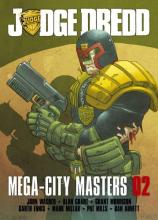Judge Dredd: Mega-City Masters, Vol. 2
Review
Judge Dredd: Mega-City Masters, Vol. 2
Even with the amazing cover by John Romita, Jr. and the inclusion of a few artists from the first volume, Judge Dredd: Mega-City Masters, Vol. Two is more about the story content than visual presentation. While the visuals remain a strong and a valuable presence to the stories, this collection highlights the diversity of Dredd's career experiences. Following a glossary of Mega-City One terminology, readers are thrust into the John Wagner and Alan Grant penned "The Comeback," an almost completely Dredd-free tale from 1988 that is quite disturbing. Originally, publisher IPC changed the name of the lead character from Michael Jackson to Jaxon Prince but left untouched references to Never Never Land, sleeping in an oxygen tent, Elephant Man bones, and a host of other innuendos alongside artist Gary Leach's photorealistic reproduction of Jackson's likeness.
Two contributions by Garth Ennis follow the Wagner-Grant collaboration. Known for his work on Preacher, Punisher, Hitman, and a host of other titles, Ennis made his 2000AD debut in 1988. One of his earliest Progs, "Talk Back" features Glenn Fabry in a fully painted, Simon Bisley-esque color palate, while "The Marshal" showcases an early venture by Sean Phillips. While Phillips is held in high regard for his noir work with Ed Brubaker, this strip is a fascinating glimpse in the process and evolution of the artist as well as a precursor for the vengeance-driven thrillers Ennis has written. The Ennis strip also illustrates the strengths of the 2000AD format—the continual, serial narrative. Divided into four parts, "The Marshal" is a strong experiment in story pacing and development unknown in longer, American series.
Following a bizarre Mark Millar story where Dredd has to dispatch a rogue tyrannosaurus who was given a Judge's badge, Millar teams with Grant Morrison for a multipart tale, "Book of the Dead." The hold and stylistic influence that Bisley had on 2000AD art during the late 1980s and early 1990s is reaffirmed here by Dermot Power. The actual story, however, is perhaps the strongest and most developed of the anthology as Dredd travels to the Egyptian city of Luxor as part of a judicial exchange program and becomes involved in some zombie-esque, undead rampage. Laden with pharaoh mythology and extreme high adrenaline action, the eight-part strip is a fascinating introduction into the collaborative efforts of Millar and Morrison before their time on Swamp Thing, Skrull Kill Krew, Vampirella, Aztek, and The Flash.
Rounding out the collection are a nice mixture of one-shot and multi-issue strips by Wagner, Simon Spurrier, Pat Mills, Ian Edgington, and Al Ewing. Where Wagner explores the inner mechanisms of the police state and the response of the citizens to this proto-fascism and Spurrier expands the world of Mega-City One to incorporate other regions such as NeoCuba into the Dredd canon, Mills utilizes the extended format to chart a story of generational crime across the centuries. One of the more visually stunning entries in this anthology is Edginton's "High Spirit.'' Dave Taylor's pencils here have an air or vibe of Moebius and Frank Quitely to them and the colors are brilliant. In fact, the longer serial format seems to fit Dredd better than the shorter vignettes as greater attention is paid to plot, setting, and overall character and story development. The investment by the writer is stronger and it pays off for the reader as well in these futuristic, dystopian epics. As a result, Edginton's tale is quite intriguing as Dredd plays second fiddle to a Exorcist Judge and the two combat an alien threat to Mega-City that rests upon the dead. The same is true for the final installment by Ewing, which looks into an alternate reality intersecting with Dredd's universe and the disappearance of criminals from his jurisdiction.
As with Judge Dredd: Mega-City Masters, Vol. One, the sequel anthology has its strong and weak strips. Interestingly, it is the selection that is somewhat puzzling as key, quintessential episodes in Dredd's career penned by Wagner, Grant, or Mills from the early period of 2000AD are absent. For example, Wagner's "Cursed Earth" or "Judge Death" story arcs greatly expanded the Dredd universe. Furthermore, while the selection of readily recognizable authors reflects the marketing of the book to Americans, the question naturally becomes were the strips chosen based on story merit or name association? Fortunately, there is a nice blend of stories in this volume and as a result, Judge Dredd: Mega-City Masters, Vol. Two serves as an excellent introductory piece to the world of Mega-City One, a world that more readers should visit via Rebellion/2000AD amazing graphic novel collections.
Reviewed by Nathan Wilson on July 9, 2012
Judge Dredd: Mega-City Masters, Vol. 2
- Publication Date: October 12, 2010
- Genres: Crime, Fiction, Graphic Novel, Mystery, Science Fiction
- Paperback: 224 pages
- Publisher: 2000 AD
- ISBN-10: 1906735956
- ISBN-13: 9781906735951





